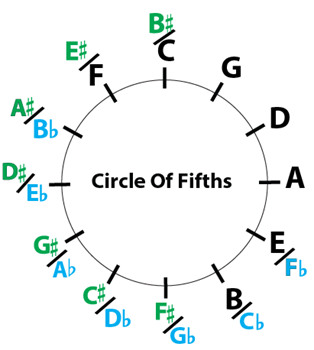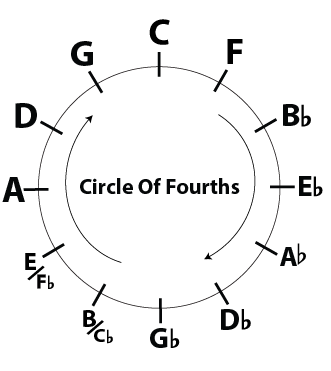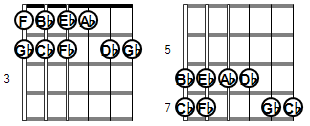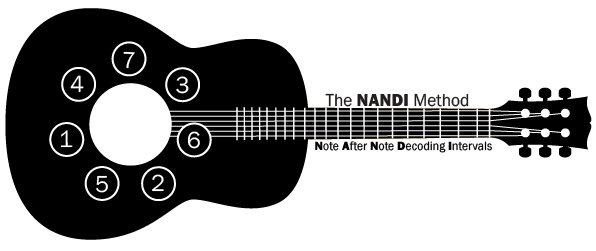Sharps and Flats: Key Signatures
Every major scale has a specific number of sharps or flats, commonly referred to as the key signature. A musical piece that is based on a major scale is said to be in a major key and when it is based on a minor scale, it is said to be in a minor key. In each key, we need to figure out which notes are sharp or flat. First, let’s recall the order of sharps and flats.
The order of sharps is in fifths and begins with F#:
F#, C#, G#, D#, A#, E#, B#
The order of flats is in fourths and begins with B♭:
B♭, E♭, A♭, D♭, G♭, C♭, F♭
We can see that the order of note names is the same for both, only that the letters in the flat sequence is in reverse order from the letters in the sharp sequence.
How does this help us determine the key signature of a given key? That is why you often find a reference to the circle of fifths to help in this task.
The chart below is a circle of fifths showing the enharmonic names for all possible key signatures.

The circle of fifths shows the order of keys in fifths when moving clockwise, and fourths when moving counterclockwise.
As we move clockwise around the circle we move into keys that contain sharps (G-D-A-E-B-F#-C#), and as we move counterclockwise we move into keys that contain flats (F♭-C♭-G♭-D♭-A♭-E♭-B♭-F).
Here is the order of sharps:
F#, C#, G#, D#, A#, E#, B#
C is the only major key with no sharps or flats.
For each letter going clockwise starting from G, you add a sharp. For example, G has one sharp. We can conclude that the key of G is comprised of G-A-B-C-D-E-F#. Let’s pick a key at random, say A, and want to determine the number of sharps. We can count that it is three steps clockwise from C, which means that it has three sharps. Using the order of sharps, we can see the first three sharps are F#, C#, and G#, so the key of A is comprised of A-B-C#-D-E-F#-G#. This is the classical method where you have to have a circle of fifths image in front of you or commit the information provided by the circle to memory, such as the names and number of sharps in each and every key.
Watch the video below to easily find key signatures using The NANDI Method. Subscribe to The NANDI Method YouTube Channel for more videos like this one!
A more expeditious way to find the sharps is to use The NANDI Method because it applies directly to your fretboard. You won’t need to have a circle of fifth/fourths on hand, nor do you have to resort to memorization. All you have to do is drop a half-step (one fret) from the root note, count up in fourths until you arrive at B. In the key of A, for example, one half-step down is G#. Moving across your fretboard in fourths, your sequence from G# would be G#, C#, F#, B. It can be concluded that there are 3 sharps in the key of A: G#, C#, and F#.
The table below shows the intervals and notes in G, D and A major in the order of fourth intervals (7-3-6-2-5-1-4).
Notice how the sharps in a key stop occurring when you arrive at the B note while counting in fourths.
KEYS 7 3 6 2 5 1 4
G F# B E A D G C
D C# F# B E A D G
A G# C# F# B E A D
E D# G# C# F# B E A
Best of all, you find these notes on the fretboard in the same order that you learn them.
Watch the video below to learn a hack to ID sharps and flats in each key:
The diagrams below show all the notes in the major keys G, D, A, and E, horizontally across all strings in an almost linear manner.

To figure out the flats in a key, let’s take a look at the Circle of Fourths below:

If we move one step clockwise from C we reach F. Remember, F is the only natural letter key that has a single flat (B♭) in its key signature. C is the only key with all natural notes. Here is the fourth order of flats:
B♭, E♭, A♭, D♭, G♭, C♭, F♭,
We can see that the first note in the sequence is B♭, so we can conclude that the key of F is comprised of F-G-A-B♭-C-D-E. If we choose the key of, say, A♭, we can see that it is four steps clockwise from C, so that means it has four flats. If we look at the order of flats, we can see the first four in the sequence are B♭, E♭, A♭, and D♭. So, the key of A♭ is comprised of A♭- B♭- C – D♭- E♭- F – G.
Counting in fourths forms the basis for the NANDI method. So, by extension you already know the order of flats. While learning to name notes on the guitar with the NANDI method, you have seen that a series of flat fourths follow F: F- B♭-E♭-A♭-D♭-G♭-C♭-F♭. For this reason, it is easy to determine that the key of F has one flat, the key of B♭ has two flats which is B♭ and the next fourth E♭, the key of E♭ has B♭, E♭ and the next fourth A♭, and so on.
You can see how the pattern of flat fourths follow F at the first fret, and the seven flats on the sixth and seventh frets on the fretboard.

